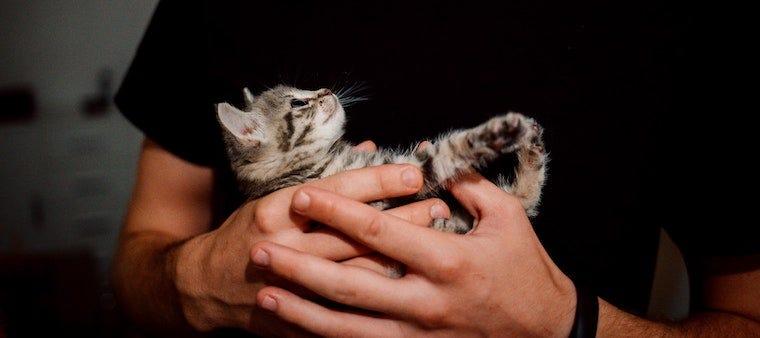Updated March 1, 2024
Although a bee sting is far more likely to occur if your cat goes outside, it’s not uncommon for a winged insect to make its way indoors during the warmer months of the year.
Humans are wary of bees and wasps flying around us, trying to stay calm so we don’t get stung. But for cats, a bee or wasp flying around might look like a fun object to bat at—which can end up in a sting. These buzzing creatures can bring out the predatory instincts in your cat, including swatting and even attempting to eat the stinging insects. If your cat is one to chase after a laser for hours on end, a bee flying in their face can also provide entertainment.
For some cats, a bee or wasp sting will be annoying and uncomfortable, but it won’t necessarily result in any other issues. Other cats may have more severe reactions to a bee sting and could require veterinary care.
Not knowing how to treat bee stings on cats or whether the reaction is severe can be scary. For instance, can cats be allergic to bee stings like people can be? Indeed, it’s possible that your cat might have an allergic reaction to a sting.
Learn more about what to watch for if your cat was stung by a bee and the next steps to take.
Was it a bee or a wasp?
Bees are less likely to sting your cat than a wasp, typically resulting in a smaller sting reaction. In addition, bees leave their stingers behind, while wasps and other flying insects keep their stingers intact—and can therefore sting more than once.
If you can locate the bee or wasp that stings your cat, you’ll better understand which caused the reaction. This might guide how you deal with the sting.
Signs your cat has been stung by a bee

Was your cat stung by a bee, a wasp, or something else? If you suspect your cat was stung, search the area for flying and crawling insects. Closely inspect the site of the sting on your cat. Here are some signs to watch out for:
- Swelling
- Irritation
- Suddenly pawing at its face
- Suddenly chewing on its paws
Your cat may show signs of discomfort and pain due to a sting, with a greater reaction to wasp stings.
Most of the time, when your cat is stung by a bee, the reaction will be localized to the area of the sting. Some reactions are milder and only result in a small bump and slight irritation. Others might involve swelling of the area around the bump, pain when it’s touched, or a life-threatening anaphylactic reaction. Regardless of what kind of creature has stung your cat, if the reaction continues to grow and shows no sign of getting better, it’s time to call your vet.
When to call a vet
Typically a sting will result in a localized reaction, including mild swelling and tenderness. Remember that a cat bee sting is more likely to occur on the face, especially near the nose or on the paw. Call your vet just to be safe, as they may advise you to bring your kitty in for an inspection or can offer treatment advice.
Like humans, some cats will be hypersensitive to a bee or wasp’s venom. After calling your vet, you’ll want to monitor your cat carefully for the next 24 hours or so. While most allergic reactions occur within 20 minutes of a sting, some can be delayed for hours.
Severe reactions can be fatal—so if you notice any of these signs in your cat, get to your veterinarian, the emergency clinic, or the animal hospital immediately.
Early signs of an extreme reaction to a bee or wasp sting include:
- Extreme swelling, redness, and/or pain
- Lameness or limping
- Distressed vocalizations
- Compulsive licking of the wound site
Signs that your cat may be going into anaphylactic shock include:
- Breaking out in hives
- Disorientation or stumbling
- Difficulty breathing
- Vomiting or diarrhea
- Excessive drooling
- Pale gums
- Low body temperature and cold limbs
- An abnormally slow or fast heart rate
- Seizures
If at any time you notice that your cat is taking a turn for the worse and having difficulty breathing or is not responsive, bring your cat to the emergency vet as soon as possible. In the case of an extreme allergic reaction, including anaphylactic shock, the veterinarian will likely administer antihistamines, corticosteroids, and/or epinephrine. They may also administer IV fluids and oxygen and perform blood and urine tests to determine if there is organ damage. Afterward, your vet may prescribe an Epi-Pen in case of future insect stings.
Removing a bee stinger
A cat stung by a bee will likely still have the stinger embedded in the skin. This is painful for your kitty, and the bee’s stinger can continue pumping venom into the wound for up to three minutes. The goal is to get the stinger out without causing further pain or trauma to your cat, which isn’t always easy.
You have to be very careful when attempting to remove the stinger. Use a credit card or driver’s license card (or even your fingernail) to gently scrape the stinger away from the direction it came in. This will help pull out the stinger in one piece without making things worse.
Some professionals say not to use tweezers or fingers to remove a stinger due to concerns of worsening the reaction. Studies have shown that speed is crucial: If the only way to remove it is by pinching it (or tweezing) and removing it, then do it. The benefit of removing the stinger outweighs the previously assumed risk of squeezing more venom into your cat (this has been disproven).
How to treat a bee sting on a cat
Fortunately, treating a cat stung by a bee typically won’t be too difficult. Use the tips below to help your kitty recover from a mild reaction to a bee or wasp sting.
Antihistamines
Ask your vet about giving your cat diphenhydramine/Benadryl, which treats mild allergic reactions. Ensure the medication only has diphenhydramine as the active ingredient and is not combined with pain relievers, decongestants, etc. This can help save you time when determining whether you should bring your cat to the vet for further treatment.
At-home remedies
Soothe the wound site by applying a thick baking soda and water paste. Or, if your cat has multiple stings, experts recommend a soothing oatmeal bath. This can help with the irritation around the sting site, easing some of your cat’s pain and promoting recovery.
Ice packs
Minimize swelling with a cold compress or ice pack. Apply an ice pack, bag of frozen peas, or cooled towel to the affected area for ten minutes to reduce swelling. Your cat might not be a fan of this, so try giving them treats or interacting with them and their favorite toy as they endure the cold.
Cone of no-shame
Use a head cone or cat booties if your cat continues to lick, scratch, or bite the healing wound site. This can help prevent further infection and allow the sting site to heal faster.
Adjust diet, if needed
Give fresh water and soft food, especially if your cat was stung in or near the mouth and is finding it difficult to eat dry food.
Watch and act
You can never predict how your cat will respond to something until it happens to them. The first time your cat is stung by a bee or wasp will give you insight into how your cat will respond. There’s no other way to determine if your cat is allergic until it happens.
If it does happen, just be prepared to monitor them for at least 24 hours to ensure they don’t suffer any other serious reactions. Even better, create a cat first aid kit to be prepared for multiple medical scenarios,
Preventing a bee sting
It may be hard to prevent your cat from interacting with insects that can sting, but there are some preventative measures that you can take to improve the possibility of never experiencing it. You may not want to keep every door and window sealed shut throughout the springtime, so you have to accept the fact that it could happen.
If you encounter a beehive or wasp nest in your house or yard, you should not attempt to take it down yourself. This puts yourself, not just your cat, at risk of being stung. You don’t want to upset the bees or wasps living in their nest and would benefit from having a professional do the work for you. Have the nest removed safely to avoid a swarm.
You may notice your cat in hunting mode, having cornered some insects inside of your home. Remove your cat from where the insect is and attempt to move it outside. You can try to open the door and direct it outside or attempt to capture it underneath a cup and set it free.
Don’t forget that bees are good for our ecosystem: We don’t want to kill them. Your first goal is simply to remove them from the premises. If that can’t happen safely, you can do what you must to get them away from your pets.
Lastly, keeping your pet entertained with plenty of toys and cat trees to climb might limit their boredom to the point where they won’t want to interact with a bee or wasp. You can ensure your cat is well cared for with the proper equipment and space to keep them engaged and happy. A few simple solutions may help keep your cat safe from any stings.
Sources:
- First Aid for Insect Stings in Cats | VCA Animal Hospitals
- Anaphylaxis in Dogs and Cats | MSPCA-Angell
- Inexperienced But Still Interested – Indoor-Only Cats Are More Inclined For Predatory Play Than Cats With Outdoor Access | ScienceDirect
- An Open Clinical Trial On The Efficacy Of Cetirizine Hydrochloride In The Management Of Allergic Pruritus In Cats | NCBI
- Why bees are so important to human life and health | Medical News Today
- Bee Stings and Insect Bites: First Aid
- Wasp, Bee, and Ant Stings to Animals









